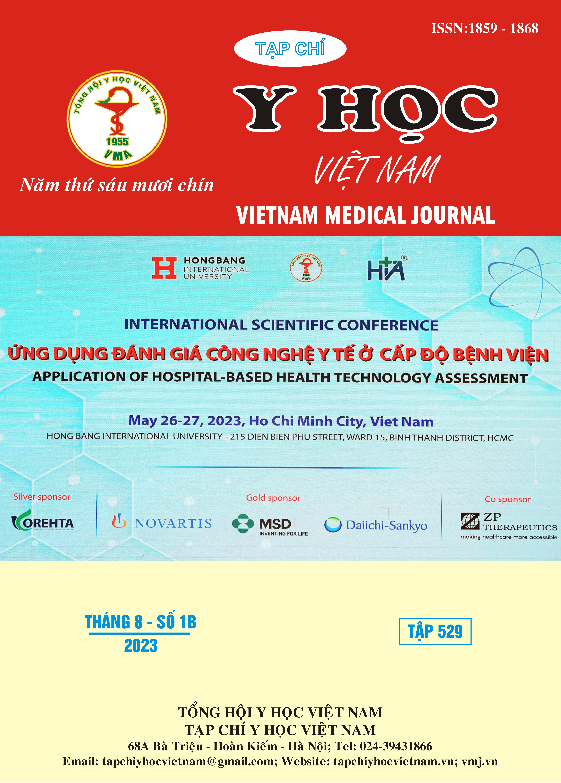MỘT SỐ YẾU TỐ LIÊN QUAN ĐẾN CHÍ SỐ NGỪNG THỞ - GIẢM THỞ (AHI) CỦA BỆNH NHÂN NGỪNG THỞ TẮC NGHẼN KHI NGỦ TẠI KHOA HÔ HẤP - BỆNH VIỆN ĐA KHOA TÂM ANH
Nội dung chính của bài viết
Tóm tắt
Đặt vấn đề: Hội chứng ngừng thở tắc nghẽn khi ngủ là bệnh lý phổ biến và được chẩn đoán bằng lâm sàng và đo đa ký giấc ngủ hoặc đa ký hô hấp1. AHI là chỉ số chỉ số ngưng thở giảm thở đánh giá mức độ nặng của hội chứng ngưng thở khi ngủ. Có nhiều yếu tố tác động đến chỉ số ngừng thở - giảm thở. Việc tìm hiểu các yếu tố này có vai trò quan trọng giúp các thầy thuốc lâm sàng nâng cao hiệu quả chẩn đoán và điều trị ngừng thở khi ngủ do tắc nghẽn. Mục tiêu: Tìm hiểu một số yếu tố liên quan đến chí số ngừng thở - giảm thở (AHI) của bệnh nhân ngừng thở tắc nghẽn khi ngủ. Đối tượng và Phương pháp: Mô tả cắt ngang 57 bệnh nhân mắc chứng ngừng thở khi ngủ phòng khám khoa Hô hấp - Bệnh viện Tâm Anh từ 3/2021 đến 2/2023. Kết quả: Chỉ số ngừng thở - giảm thở (AHI) trung bình của nhóm nghiên cứu là 35,1 ± 24,16. Số bệnh nhân mắc bệnh mức độ trung bình - nặng chiếm 77,2%. AHI có tương quan vừa với chu vi vòng cổ (r = 0,523; p < 0,001), chỉ số khối cơ thể (r = 0,359; p < 0,01), % thời gian độ bão hòa oxy máu < 90% (r = 0,491; p < 0,01), độ bão hòa oxy máu nền (r = -0,425; p < 0,01), độ bão hòa oxy máu thấp nhất (r = -0,584; p < 0,001). AHI có sự khác biệt có ý nghĩa thống kê ở tư thể nằm ngửa so với nằm sấp và nằm nghiêng (p < 0,001). Kết luận: Chỉ số ngừng thở - giảm thở trong nghiên cứu có mối liên quan với nhiều yếu tố: Chu vi vòng cổ, chỉ số khối cơ thể, tư thế nằm ngủ, độ bão hoà oxy máu khi ngủ. Do vậy, cần đánh giá toàn diện hội chứng ngừng thở khi ngủ do tắc nghẽn và điều trị kịp thời cho người bệnh
Chi tiết bài viết
Từ khóa
Hội chứng ngừng thở tắc nghẽn khi ngủ, chỉ số ngừng thở - giảm thở, OSA, AHI.
Tài liệu tham khảo
2. Collop NA, Anderson WM, Boehlecke B, et al. Clinical guidelines for the use of unattended portable monitors in the diagnosis of obstructive sleep apnea in adult patients. Portable Monitoring Task Force of the American Academy of Sleep Medicine. Journal of clinical sleep medicine : JCSM : official publication of the American Academy of Sleep Medicine. 2007;3(7):737-747.
3. Tufik S, Santos-Silva R, Taddei JA, Bittencourt LR. Obstructive sleep apnea syndrome in the Sao Paulo Epidemiologic Sleep Study. Sleep Med. 2010;11(5):441-446.
4. Gharib A, Loza S. Factors affecting the severity of the apnea hypoapnea index: a retrospective study on 838 Egyptian patients diagnosed with obstructive sleep apnea. The Egyptian Journal of Bronchology. 2020;14(1):34.
5. Kim SE PB, Park SH,. Predictors for Presence and Severity of Obstructive Sleep Apnea in Snoring Patients: Significance of Neck Circumference. J Sleep Med. 2015;12(2):34-38.
6. Bozkurt MK, Oy A, Aydin D, et al. Gender differences in polysomnographic findings in Turkish patients with obstructive sleep apnea syndrome. Eur Arch Otorhinolaryngol. 2008;265(7):821-824.
7. Guimarães C, Martins MV, Vaz Rodrigues L, Teixeira F, Moutinho Dos Santos J. Epworth Sleepiness Scale in obstructive sleep apnea syndrome--an underestimated subjective scale. Revista portuguesa de pneumologia. 2012;18(6):267-271.
8. Akita Y, Kawakatsu K, Hattori C, Hattori H, Suzuki K, Nishimura T. Posture of Patients with Sleep Apnea During Sleep. Acta oto-laryngologica. 2003;123(543):41-45.
9. Wang L, Wei DH, Zhang J, Cao J. Time Under 90% Oxygen Saturation and Systemic Hypertension in Patients with Obstructive Sleep Apnea Syndrome. Nature and science of sleep. 2022;14:2123-2132.


